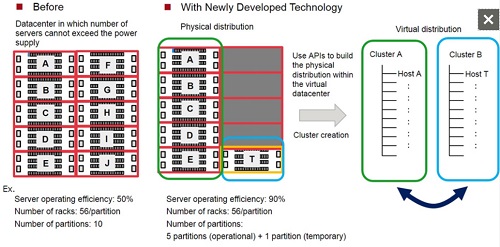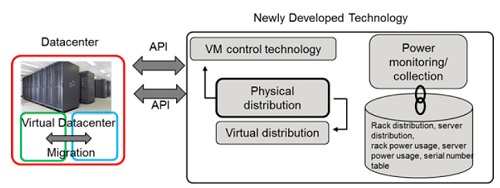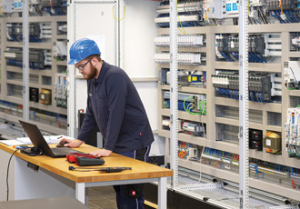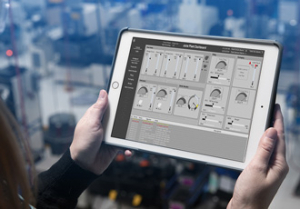VM control technology to improve server density of data centre racks
The development of Virtual Machine (VM) control technology that improves server rack mounting density for each data centre rack has been announced by Fujitsu Laboratories.
Currently, in data centres, the number of servers mounted to a rack is limited by the total rated electrical power of the servers, which must be less than the power supply of the rack. However, often times, server load is low, at approximately 10-50%, and power usage for each rack proportional to load is also low compared to the rated power, leading to racks with low server mounting density.
Now, in order to increase server mounting density, Fujitsu Laboratories has developed technology that enables efficient server placement by setting up a partition made up of backup servers in the data centre, and migrating VMs to the backup partition based on the physical distribution and power consumption of the virtual machines.
With this technology, for racks that are running virtual servers, data centres can reduce their space usage by increasing mounting density. Fujitsu Laboratories has calculated that in a case where server rack operational efficiency was increased to 90%, space usage could be reduced by 40%.
Details of this technology were presented at IEEE Cloud 2017, an international conference which was held in Honolulu, US, from June 25-30th.
Development background
As the number of servers installed in data centres continues to rise and its further increase is expected with the growth of AI and IoT systems going forward, there has been a demand for ways to increase server mounting density within the bounds of limited space and power.
Issues
In data centres, when installing servers in a rack, the number of servers is decided based on the rated power usage of each server, so as not to exceed the rack's power supply. However, often times, server load is low, at approximately 10-50%, and power usage for each rack proportional to load is also low compared to the rated power. Being this low creates a demand to raise mounting density.
In response to this demand, in recent years a 'power capping technology' has been developed which monitors the actual operational status of servers in racks that mount a number of servers in excess of their power supplies. If that power supply is about to be exceeded, the technology limits the operational frequency of servers to suppress power consumption. This technology, however, could not be used for applications that require a specified level of processing performance, such as mission-critical applications.
Newly developed technology
Now Fujitsu Laboratories has developed a VM control algorithm that first installs physical servers in racks at high density in a data centre and then establishes a back-up partition, using the migration functionality of the VMs to move them depending on the power consumption of each server. In this way it prevents each rack from exceeding its amount of power supply.
Features of the newly developed technology are as follows:
1. VM control technology based on physical distribution Virtual data centres built with VM management software have physical servers split into theoretical management units called clusters. The physical servers within a cluster can be mounted into different racks, with no physical limitations. VMs are automatically migrated between clusters when a physical server stops operation due to a fault or when it undergoes maintenance. The actual physical layout of the servers, however, is not always taken into account.
Fujitsu Laboratories has now developed a technology that prevents racks from exceeding their power supplies. Using an API that can be used in normal data centre management, the company will build a database related to the physical distribution (the operational partition) of servers that provides services as well as the physical distribution of the backup partition that the VMs will be migrated to as it approaches its power supply limits. Then, the continually changing power usage volume collected from the servers will be linked to their serial number and rack number. This technology enables data centre operators to increase the mounting density in the operational partitions, reducing space usage.
 Figure 1: Increasing server mounting density in a data centre
Figure 1: Increasing server mounting density in a data centre
 Figure 2: VM control technology based on physical distribution
Figure 2: VM control technology based on physical distribution
2. Technology to set installation rules based on actual operational data
Frequent migrations will occur if server mounting density is increased exceedingly, so an appropriate balance is necessary between migration frequency and server load commensurate with power volume. Fujitsu Laboratories has now developed a technology to determine the number of servers that should be mounted on a rack by statistically estimating the frequency of migrations for each rack, based on the pre-measured load per server, assuming that changes in the load follow the normal distribution (Figure 3). If the centre of the normal distribution is a server load of 30%, for example, by installing servers based on a power usage value for 50% load, this would account for 95.5% of changes in load, enabling a maximisation of server mounting density.
 Figure 3: Technology for setting rules for server installation
Figure 3: Technology for setting rules for server installation
Effects
By applying this technology, Fujitsu Laboratories expects that it will be possible to increase the mounting density of servers in data centres, significantly reducing installation space. By using this newly developed technology, for example in a cloud service where changes in load can be predicted with a normal distribution, a data centre operating with ten partitions at a server rack operating efficiency of 50% would be able to reduce space usage by 40%, with now five partitions and a server operating efficiency of 90%.
Similar articles
More from Fujitsu
- Sensor estimates degree of damage to bridge infrastructure 1st September 2017
- VM control technology to improve server density of data centre racks 5th July 2017
- MEXT award Fujitsu Science and Technology prize 18th April 2017
- Equipment maintenance management system meets customer needs 12th January 2017




 technology at Jacobs Vehicle Systems.JPG)







Write a comment
No comments